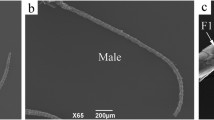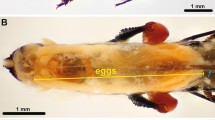Abstract
Sensory receptors of the ovipositor ofTrichogramma maidis are described. Sense organs are found on the 2nd valvifers (1 type), on the tip of the 3rd valvulae (2 types) and on the 1st valvulae (4 types). The nature and possible functions of these sensilla are discussed.
Résumé
Des récepteurs sensoriels ont été mis en évidence sur l'ovipositeur deT. maidis. Il existe des sensilles sur les valvifères 2 (1 type), l'extrémité des valves 3 (2 types) et les valves 1 (4 types). La nature et le rôle possibles de ces organes sont discutés.
Similar content being viewed by others
References
Austin, A. D. &Browning, T. O. — 1981. A mechanism for movement of eggs along insect ovipositors. —J. Insect Morphol. & Embryol., 10, 93–108.
Domenichini, G. — 1977–1978. Some structures of variousHymenoptera Chalcidoidea and their functions. —Bull. Zool. Agr. Bachic. Ser. II, 14, 29–93.
Ganesalingam, V. K. — 1972. Anatomy and histology of the sense organs of the ovipositor of the Icheneumonid wasp,Devorgilla canescens. —J. Insect Physiol. 18, 1857–1867.
Ganesalingam, V.K. — 1974. Mechanism of host discrimination between parasitized and unparasitized hosts byVenturia canescens [Hym.: Ichneumonidae]. —Entomol. Exp. & Appl., 17, 36–44.
Greany, P. D. &Oatman, E. R. — 1972. Analysis of host discrimination in the parasiteOrgilus lepidus [Hym.: Braconidae]. —Ann. Entomol. Soc. Am., 65, 377–383.
Greany, P. D., Hawke, S. D., Carlyse, T. C. &Anthony, D. W. — 1977. Sense organs in the ovipositor ofBiosteres (Opius) longicaudatus, a parasite of the Caribbean fruit flyAnastrepha suspensa. —Ann. Entomol. Soc. Am., 70, 391–321.
Hawke, S. D., Farley, R. D. &Greany, P. D. — 1973. The fine structure of sense organs in the ovipositor of the parasitic waspOrgilus lepidus Muesbeck. —Tissue Cell, 5, 171–184.
Hermann, H. R. &Douglas, M. E. — 1976. Comparative survey of the sensory structures on the sting and the ovipositor of hymenopterous insects. —J. Georgia Entomol. Soc., 11, 223–239.
Hofsvang, T. — 1988. Mechanisms of host discrimination and intraspecific competition in the aphid parasitoidEphedrus cerasicola. —Entomol. Exp. & Appl., 48, 233–239.
Kainoh, Y. &Tatsuki, S. — 1988. Host egg kairomones essential for the egg-larval parasitoid,Ascogaster reticulatus Watanabe [Hym.: Braconidae] I. Internal and external kairomones. —J. Chem. Ecol., 14, 1475–1484.
King, P. E. &fordy, M. R. — 1970. The external morphology of the “pore” structures on the tip of the ovipositor inHymenoptera —Entomol. mon. Mag., 106, 245–254.
King, P. E. &Rafai, J. — 1970. Host discrimination in a gregarious parasitoidNasonia vitripennis (Walker) [Hym.: Pteromalidae]. —J. Exp. Biol., 53, 245–254.
Klomp, K., Teerink, B. J. &Wei Chun Ma. — 1980. Discrimination between parasitized and unparasitized hosts in the egg parasiteTrichogramma embryophagum [Hym.: Trichogrammatidae]: a matter of learning and forgetting. —Neth. J. Zool., 30, 254–277.
Lenteren, J. C. Van — 1972. Contact-chemoreceptors on the ovipositor ofPseudeucoila bochei Weld [Cynipidae]. —Neth. J. Zool., 22, 347–350.
Le Ralec, A. &Rabasse J. M. — 1988. Structure, sensory receptors and operation of the ovipositor of threeAphidiidae. In: Ecology and effectiveness ofAphidophaga (E. Niemczyk &A. F. G. Dixon, eds.). —SPB Academic Publishing, The Hague, 83–88.
Matsuda, R. — 1976. TheHymenoptera. In: Morphology and Evolution of the Insect Abdomen. —Pergamon Press, New York, 373–396.
Salt, G. — 1937. The sense used byTrichogramma to distinguish between parasitized and unparasitized hosts. —Proc. R. Soc. Lond., 122, 57–75.
Smith, E. L. — 1970. Evolutionary Morphology of the External Insect Genitalia. 2Hymenoptera. —Ann. Entomol. Soc. Am., 63, 1–27.
Strand, M. R. — 1986. The physiological interactions of parasitoids with their hosts and their influence on reproductive strategies. In: Insect Parasitoids (J. Waage & D. Greathead, eds.). —Academic Press, 97–138.
Tilden, R. L. &Ferkovitch, S. M. — 1988. Kairomonal stimulation of oviposition in an artificial substrate by the endoparasitoidMicroplitis croceipse [Hym.: Braconidae]. —Ann. Entomol. Soc. Am., 81, 152–156.
Veen, J. C. Van &Wijk, M. L. E. Van — 1985. The unique structure and functions of the ovipositor of the non-paralyzing ectoparasitoidColpoclypeus florus Walk. [Hym.: Eulophidae] with special reference to antennal sensilla and immature stages. —J. Appl. Entomol., 99, 511–531.
Wu Z. X. &Qin, J. — 1982. Ovipositional response ofTrichogramma dendrolimi to the chemical contents of artificial eggs. —Acta Entomol. Sin., 25, 363–372.
Wylie, H. G. — 1971. Oviposition restraint ofMuscidifurax zaraptor [Hym.: Pteromalidae] on the parasitized housefly pupae. —Can. Entomol., 103, 1537–1544.
Author information
Authors and Affiliations
Rights and permissions
About this article
Cite this article
Le Ralec, A., Wajnberg, E. Sensory receptors of the ovipositor ofTrichogramma maidis [Hym.:Trichogrammatidae]. Entomophaga 35, 293–299 (1990). https://doi.org/10.1007/BF02374805
Received:
Accepted:
Issue Date:
DOI: https://doi.org/10.1007/BF02374805




